Look-Alike Brands
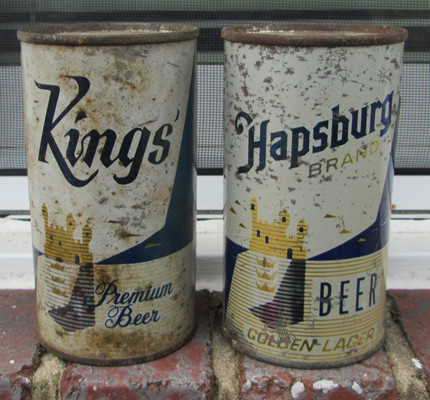 |
This month let's look at a favorite example of a "look alike" cans. I covered DBD ("doing business as") before. A DBA brewery uses a different name from the more commonly-known name of the business. I showed a Hals that was from Arrow and the white Valley Forge flats from the early 1950s. This is a another example. The Kings is from Kings Brewery in Chicago, and the Hapsburg is from Hapsburg, also in Chicago. In reality both were from Canadian Ace, a brewery that was famous, or infamous, for making beers under a bunch of different names. In some cases they were store brands. The Hapsburg fits another popular model, buying an old brand from a now-defunct competitor and selling it as a "popularly priced" (i.e. cheap) beer.
Canadian Ace
Canadian Ace was originally Manhattan Brewing, famous for its longtime ties to the Mafia dating to Prohibition. (No, it was not "Al Capone's brewery". He was out of the picture, first in prison, then dying of syphilis, by then). The brewery changed names in 1947, apparently because the old Manhattan name was too tied in the public mind to organized crime. Even after the brewery changed names, the ties were there, however. Lou Greenberg, Al Capone's old finance guy, was the brewery's principal owner. He was killed by two unknown gunmen outside his home in December 1955.
Canadian Ace was one of the most prolific breweries using different names as DBAs. They used at least 35 different brewery names between 1953 and their closing for good in 1968. Some of the other names they used, such as Jester, matched store brands. But they also bought rights to brands from local competitors that had closed. That allowed them to make and sell additional brands with (theoretically) some built-in brand loyalty. With over 100 brands competing for shelf space in Chicago by the late 1950s, every additional brand meant a chance at a little more shelf space.
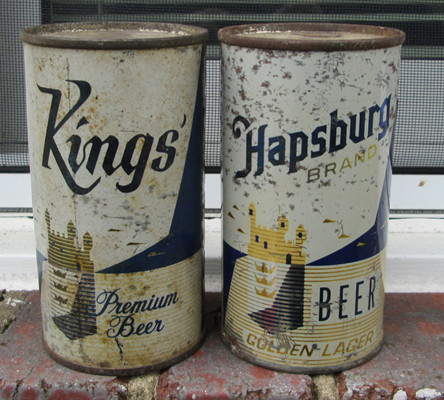 |
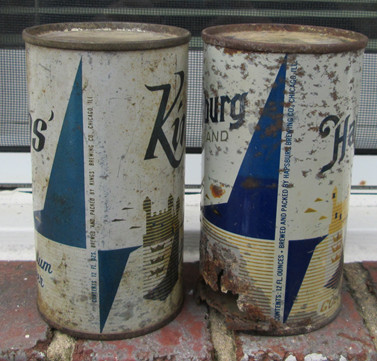 |
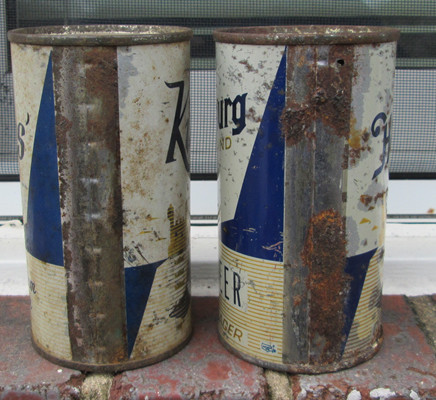 |
Hapsburg
Hapsburg was one of these old brands. Hapsburg had been made by Chicago's Best Brewing which closed in 1961. A longtime local brand, it presumably had some local brand loyalty. Canadian Ace made Hapsburg from 1964 to 1967, so this can is rather late for a flat top. They had produced Kings beer from 1959-1962 and essentially reused the old design.
Why reuse the old label? There are a few possibilities.
1. To take advantage of brand loyalty. But there's no evidence Kings was that popular a beer.
2. To take advantage of label-familarity. That's different from brand loyalty in that they were not trying to get people who said "oh hey, I liked Kings, maybe this is the same thing!" Rather, it was aimed at people buying beer quickly, without a lot of thought, who would gravitate towards a label that looked familiar. They were in the beer aisle, and reached over to grab a brand was was cheap, it was "good enough", and the label subconsciously looked familiar.
3. To save money by reusing an old design. This one strikes me as likely. In addition, the Hapsburg was made by National Can. National seemed to have been one of the more cost-efficient companies, and their cans from this era are very commonly "paint-overs" of earlier labels. They would take unused sheets of other labels, put a primer on them, and then paint the new label on top of them. (I showed a different type of paint over, a Wagner's can, earlier) Although there no reason why the brewery's decision could not have been a combination of factors including cost.
Other Canadian Ace DBA's
Here are the other names Canadian Ace used in the 1950s and 1960s
Ace
Ace Hi
Allied
Berlin
Bismarck
Cold Brau
Crest
Empire
Essex
Gipps
Gold Brau
Hapsburg
Jester
Kings
Koenig Brau
Kol
Leisy
Lubeck
Malt Marrow
9-0-5
Old Missouri
Old Vienna
Pilsen
Prima
Prima-Bismarck
Royal
Schultz
Star Union
Superior
Tudor
United States
Westminister
Windsor
Finally
One reason why I like this pair of cans is that they were featured in Lew Cady's Beer Can Collecting, published in 1976. I read and reread Cady's book when it came out. It has some errors, which were corrected in a second edition, but to a new collector it was a revelation and my copy fell apart from frequent reading. On page 84 there is a B&W side-by-side photo of the cans with a caption "to save money the brewery probably decided to reuse an old set of plates."
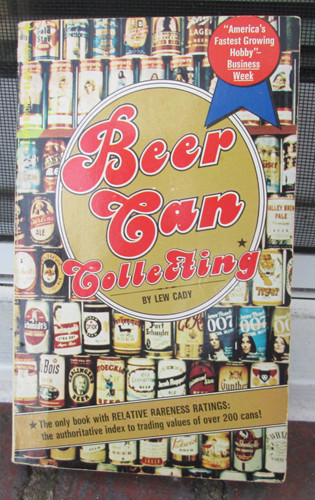 |
Sources Used
Cady, Lew. Beer Can Collecting (Grosset & Dunlap, 1976) 84.
Skilnik, Bob. The History of Beer and Brewing in Chicago, 1833-1978. (Pogo Press, 1999) 196-200.
Van Wieren, Dale P. American Breweries II (West Point, PA.: East Coast Breweriana Association, 1995) 78.
